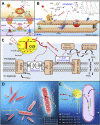Photocatalytic Material-Microbe Hybrids: Applications in Environmental Remediations
- PMID: 35174148
- PMCID: PMC8841475
- DOI: 10.3389/fbioe.2021.815181
Photocatalytic Material-Microbe Hybrids: Applications in Environmental Remediations
Abstract
Environmental pollution has become one of the most urgent global issues that we have to face now. Searching new technologies to solve environmental issues is of great significance. By intimately coupling photocatalytic materials with microbes, the emerging photocatalytic material-microbe hybrid (PMH) system takes advantages of the high-efficiency, broad-spectrum light capture capability of the photocatalytic material and the selectivity of microbial enzymatic catalysis to efficiently convert solar energy into chemical energy. The PMH system is originally applied for the solar-to-chemical production. Interestingly, recent studies demonstrate that this system also has great potential in treating environmental contaminations. The photogenerated electrons produced by the PMH system can reductively decompose organic pollutants with oxidative nature (e.g., refractory azo dyes) under anaerobic circumstances. Moreover, based on the redox reactions occurring on the surface of photocatalysts and the enzymatic reactions in microbes, the PMH system can convert the valences of multiple heavy metal ions into less toxic or even nontoxic status simultaneously. In this review, we introduce the recent advances of using the PMH system in treating environmental pollutions and compare this system with another similar system, the traditional intimately coupled photocatalysis and biodegradation (ICPB) system. Finally, the current challenges and future directions in this field are discussed as well.
Keywords: environmental remediation; hybrid; microbe; photocatalytic material; solar power.
Copyright © 2022 Yu, Wang, Teng, Zupanic, Guo, Tang and Liang.
Conflict of interest statement
The authors declare that the research was conducted in the absence of any commercial or financial relationships that could be construed as a potential conflict of interest.
Figures


Similar articles
-
Eradicating the Photogenerated Holes in a Photocatalyst-Microbe Hybrid System: A Review.ACS Appl Mater Interfaces. 2024 Oct 23;16(42):56545-56554. doi: 10.1021/acsami.4c12355. Epub 2024 Oct 15. ACS Appl Mater Interfaces. 2024. PMID: 39404055 Review.
-
Degradation of organic pollutants by intimately coupling photocatalytic materials with microbes: a review.Crit Rev Biotechnol. 2021 Mar;41(2):273-299. doi: 10.1080/07388551.2020.1869689. Epub 2021 Feb 1. Crit Rev Biotechnol. 2021. PMID: 33525937 Review.
-
Photocatalytic material-microorganism hybrid systems in water decontamination.Trends Biotechnol. 2025 May;43(5):1031-1047. doi: 10.1016/j.tibtech.2024.11.012. Epub 2024 Dec 7. Trends Biotechnol. 2025. PMID: 39645524 Review.
-
Multinary I-III-VI2 and I2-II-IV-VI4 Semiconductor Nanostructures for Photocatalytic Applications.Acc Chem Res. 2016 Mar 15;49(3):511-9. doi: 10.1021/acs.accounts.5b00535. Epub 2016 Feb 11. Acc Chem Res. 2016. PMID: 26864703
-
Intimate coupling of photocatalysis and biodegradation for wastewater treatment: Mechanisms, recent advances and environmental applications.Water Res. 2020 May 15;175:115673. doi: 10.1016/j.watres.2020.115673. Epub 2020 Feb 28. Water Res. 2020. PMID: 32171097 Review.
References
-
- Berrazeg M., Deriet A., De Keersmaecker S. C. J., Verhaegen B., Vanneste K., Botteldoorn N., et al. (2019). Whole-Genome Sequencing of Multidrug-Resistant Escherichia coli Strains Harboring the Mcr-1 Gene, Isolated from Seawater of the Algiers Coast in Algeria. Microbiol. Resour. Announc 8 (34), e00638–19. 10.1128/MRA.00638-19 - DOI - PMC - PubMed
-
- Byrne C., Subramanian G., Pillai S. C. (2018). Recent Advances in Photocatalysis for Environmental Applications. J. Environ. Chem. Eng. 6 (3), 3531–3555. 10.1016/j.jece.2017.07.080 - DOI
-
- Du Y., Guo J., Chen Z., Song Y., Lu C., Han Y., et al. (2020). A New Solar-Driven Biological Wastewater Treatment Technology Based on the Synergy of Photosensitizers and Non-photosynthetic Bacteria. Int. Biodeterioration Biodegradation 155, 105111. 10.1016/j.ibiod.2020.105111 - DOI
Publication types
LinkOut - more resources
Full Text Sources

